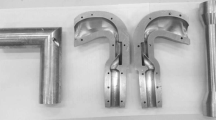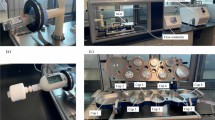Abstract
This work aimed to evaluate the relative inhalation parameters that affect the deposition of inhaled aerosols, including mouth-throat morphology, airflow rate, and initial condition of emitted particles. In vitro experiments were conducted using the US Pharmacopeia (USP) throat and a realistic mouth-throat (RMT) with Handihaler®. Then, in silico study of the gas-solid flow was performed by computational fluid dynamics and discrete phase method. Results indicated that aerosol deposition in RMT was higher compared to that in USP throat at an airflow rate of 30 L/min, with 33.16 ± 7.84% and 21.11 ± 7.1% lung deposition in USP throat and RMT models, respectively, which showed a better correlation with in vivo data from the literature. Increasing airflow rate resulted in better drug aerosolization, while the fine particle dose trend ascended before declining, with the peak value obtained at a flow rate of 40 L/min. Overall, the effect of geometrical variation was more significant. Additionally, in silico results demonstrated clearly that the initial conditions of the emitted particles from inhalers affected the subsequent deposition. Larger momentum possessed by the central aerosol jet entering the mouth directly led to stronger impaction, which resulted in the deposition in the front region of mouth-throat models. This study is beneficial to develop an in silico method to understand the underlying mechanisms of in vivo mouth-throat deposition.











Similar content being viewed by others
References
Altman P, Wehbe L, Dederichs J, Guerin T, Ament B, Moronta MC, Pino AV, Goyal P. Comparison of peak inspiratory flow rate via the Breezhaler®, Ellipta® and HandiHaler® dry powder inhalers in patients with moderate to very severe COPD: a randomized cross-over trial. Bmc Pulm Med. 2018;18:100–0. https://doi.org/10.1186/s12890-018-0662-0.
ANSYS. Fluent 19 R3 user guide. USA: Canonsburg PA; 2019.
Behara SRB, Larson I, Kippax P, Stewart P, Mortona DAV. Insight into pressure drop dependent efficiencies of dry powder inhalers. European Journal of Pharmaceutical Sciences. 2012;46:142–8.
Below A, Bickmann D, Breitkreutz J. Assessing the performance of two dry powder inhalers in preschool children using an idealized pediatric upper airway model. Int J Pharmaceut. 2013;444:169–74. https://doi.org/10.1016/j.ijpharm.2013.01.007.
Berkenfeld K, Bernauer M, McConville JT, Lamprecht A. Investigating cascade impactor performance using a modified 3D printed induction port. Int J Pharmaceut. 2018;535:402–9. https://doi.org/10.1016/j.ijpharm.2017.10.039.
Borgström L, Newman S. Total and regional lung deposition of terbutaline sulphate inhaled via a pressurised MDI or via Turbuhaler®. Int J Pharmaceut. 1993;97:47–53. https://doi.org/10.1016/0378-5173(93)90125-Y.
Borgström L, Nilsson M. A Method for Determination of the Absolute Pulmonary Bioavailability of Inhaled Drugs: Terbutaline. Pharm Res-Dordr. 1990;7:1068–70. https://doi.org/10.1023/A:1015951402799.
Borgström L, Newman S, Weisz A, Morén F. Pulmonary Deposition of Inhaled Terbutaline: Comparison of Scanning Gamma Camera and Urinary Excretion Methods. J Pharm Sci-Us. 1992;81:753–5. https://doi.org/10.1002/jps.2600810807.
Brand P, Meyer T, Weuthen T, Timmer W, Berkel E, Wallenstein G, Scheuch G. Lung deposition of radiolabeled tiotropium in healthy subjects and patients with chronic obstructive pulmonary disease. J Clin Pharmacol. 2007;47:1335–41. https://doi.org/10.1177/0091270006295788.
Chen X, Feng Y, Zhong W, Kleinstreuer C. Numerical investigation of the interaction, transport and deposition of multicomponent droplets in a simple mouth-throat model. J Aerosol Sci. 2017;105:108–27. https://doi.org/10.1016/j.jaerosci.2016.12.001.
Cheng YS. Mechanisms of Pharmaceutical Aerosol Deposition in the Respiratory Tract. Aaps Pharmscitech. 2014;15:630–40. https://doi.org/10.1208/s12249-014-0092-0.
Cheng YS, Zhou Y, Chen BT. Particle deposition in a cast of human oral airways. Aerosol Sci Tech. 1999;31:286–300. https://doi.org/10.1080/027868299304165.
Chodosh, S., Flanders, J.S., Kesten, S., Serby, C.W., Hochrainer, D., Jr, W.T., 2001. Effective delivery of particles with the HandiHaler® Dry powder inhalation system over a range of chronic obstructive pulmonary disease severity. J Aerosol Med 14, 309-315. https://doi.org/10.1089/089426801316970268
Cui X, Gutheil E. Three-dimensional unsteady large eddy simulation of the vortex structures and the mono-disperse particle dispersion in the idealized human upper respiratory system. J Aerosol Sci. 2017;114:195–208. https://doi.org/10.1016/j.jaerosci.2017.09.005.
DeHaan WH, Finlay WH. In vitro monodisperse aerosol deposition in a mouth and throat with six different inhalation devices. J Aerosol Med. 2001;14:361–7. https://doi.org/10.1089/089426801316970321.
Dehbi A. A CFD model for particle dispersion in turbulent boundary layer flows. Nuclear Eng Design. 2008;238:707–15. https://doi.org/10.1016/j.nucengdes.2007.02.055.
Delvadia R, Hindle M, Longest PW, Byron PR. In Vitro Tests for Aerosol Deposition II: IVIVCs for Different Dry Powder Inhalers in Normal Adults. J Aerosol Med Pulm D. 2013a;26:138–44. https://doi.org/10.1089/jamp.2012.0975.
Delvadia RR, Longest PW, Hindle M, Byron PR. In Vitro Tests for Aerosol Deposition. III: Effect of Inhaler Insertion Angle on Aerosol Deposition. J Aerosol Med Pulm D. 2013b;26:145–56. https://doi.org/10.1089/jamp.2012.0989.
Donovan MJ, Kim SH, Raman V, Smyth HD. Dry powder inhaler device influence on carrier particle performance. J Pharmaceutic Sci. 2012;101:1097–107. https://doi.org/10.1002/jps.22824.
Golshahi L, Noga ML, Finlay WH. Deposition of inhaled micrometer-sized particles in oropharyngeal airway replicas of children at constant flow rates. J Aerosol Sci. 2012;49:21–31. https://doi.org/10.1016/j.jaerosci.2012.03.001.
Golshahi L, Noga ML, Vehring R, Finlay WH. An In vitro Study on the Deposition of Micrometer-Sized Particles in the Extrathoracic Airways of Adults During Tidal Oral Breathing. Ann Biomed Eng. 2013;41:979–89. https://doi.org/10.1007/s10439-013-0747-0.
Gosman, A. D., Loannides, E., 1983. Aspects of Computer Simulation of Liquid-Fueled Combustors. J Energy, 7, 482-490. https://doi.org/https://doi.org/10.2514/3.62687
Grgic B, Finlay WH, Burnell PKP, Heenan AF. In vitro intersubject and intrasubject deposition measurements in realistic mouth-throat geometries. J Aerosol Sci. 2004a;35:1025–40. https://doi.org/10.1016/j.jaerosci.2004.03.003.
Grgic B, Finlay WH, Heenan AF. Regional aerosol deposition and flow measurements in an idealized mouth and throat. J Aerosol Sci. 2004b;35:21–32. https://doi.org/10.1016/S0021-8502(03)00387-2.
Heenan AF, Finlay WH, Grgic B, Pollard A, Burnell PKP. An investigation of the relationship between the flow field and regional deposition in realistic extra-thoracic airways. J Aerosol Sci. 2004;35:1013–23. https://doi.org/10.1016/j.jaerosci.2004.03.004.
Hirst PH, Bacon RE, Pitcairn GR, Silvasti M, Newman SP. A comparison of the lung deposition of budesonide from Easyhaler®, Turbuhaler® and pMDI plus spacer in asthmatic patients. Resp Med. 2001;95:720–7. https://doi.org/10.1053/rmed.2001.1107.
Hoppentocht M, Hagedoorn P, Frijlink HW, de Boer AH. Technological and practical challenges of dry powder inhalers and formulations. Adv Drug Deliver Rev. 2014;75:18–31. https://doi.org/10.1016/j.addr.2014.04.004.
Horváth A, Balásházy I, Tomisa G, Farkas Á. Significance of breath-hold time in dry powder aerosol drug therapy of COPD patients. Eur J Pharm Sci. 2017;104:145–9. https://doi.org/10.1016/j.ejps.2017.03.047.
Huang F, Zhang Y, Tong ZB, Chen XL, Yang RY, Yu AB. Numerical investigation of deposition mechanism in three mouth–throat models. Powder Technology. 2021a;378:724–35. https://doi.org/10.1016/j.powtec.2018.11.095.
Huang F, Zhu Q, Zhou X, Gou D, Yu J, Li R, Tong Z, Yang R. Role of CFD based in silico modelling in establishing an in vitro-in vivo correlation of aerosol deposition in the respiratory tract. Adv Drug Deliv Rev. 2021b;170:369–85. https://doi.org/10.1016/j.addr.2020.09.007.
Jayaraju ST, Brouns M, Verbanck S, Lacor C. Fluid flow and particle deposition analysis in a realistic extrathoracic airway model using unstructured grids. Journal of Aerosol Science. 2007;38:494–508. https://doi.org/10.1016/j.jaerosci.2007.03.003.
Kwok PCL, Wallin M, Dolovich MB, Chan HK. Studies of Radioaerosol Deposition in the Respiratory Tract. Semin Nucl Med. 2019;49:62–70. https://doi.org/10.1053/j.semnuclmed.2018.10.014.
Leung SSY, Tang P, Zhou Q, Tong ZB, Leung C, Decharaksa J, Yang RY, Chan HK. De-agglomeration Effect of the US Pharmacopeia and Alberta Throats on Carrier-Based Powders in Commercial Inhalation Products. Aaps Journal. 2015;17:1407–16. https://doi.org/10.1208/s12248-015-9802-0.
Li Z. Particle Deposition in Oral-tracheal Airway Models with Very Low Inhalation Profiles. J Bionic Eng. 2012;9:252–61. https://doi.org/10.1016/s1672-6529(11)60106-6.
Li WI, Perzl M, Heyder J, Langer R, Brain JD, Englmeier KH, Niven RW, Edwards DA. Aerodynamics and aerosol particle deaggregation phenomena in model oral-pharyngeal cavities. J Aerosol Sci. 1996;27:1269–86. https://doi.org/10.1016/0021-8502(96)00046-8.
Longest PW, Hindle M, Das Choudhuri S, Xi JX. Comparison of ambient and spray aerosol deposition in a standard induction port and more realistic mouth-throat geometry. J Aerosol Sci. 2008;39:572–91. https://doi.org/10.1016/j.jaerosci.2008.03.008.
Matida EA, Finlay WH, Lange CF, Grgic B. Improved numerical simulation of aerosol deposition in an idealized mouth-throat. J Aerosol Sci. 2004;35:1–19. https://doi.org/10.1016/S0021-8502(03)00381-1.
Menter FR, Langtry RB, Likki SR, Suzen YB, Huang PG, Völker S. A Correlation-Based Transition Model Using Local Variables-Part I: Model Formulation. J Turbomach. 2004;128:413–22. https://doi.org/10.1115/1.2184352.
Menter FR, Langtry R, Völker S. Transition Modelling for General Purpose CFD Codes. Flow Turbul Combust. 2006;77:277–303. https://doi.org/10.1007/s10494-006-9047-1.
Moon C, Smyth HDC, Watts AB, Williams RO. Delivery Technologies for Orally Inhaled Products: an Update. AAPS PharmSciTech. 2019;20:117. https://doi.org/10.1208/s12249-019-1314-2.
Newman SP, Chan HK. In vitro-in vivo correlations (IVIVCs) of deposition for drugs given by oral inhalation. Adv Drug Deliver Rev. 2020;167:135–47. https://doi.org/10.1016/j.addr.2020.06.023.
Newman SP, Morén F, Trofast E, Talaee N, Clarke SW. Terbutaline sulphate Turbuhaler: effect of inhaled flow rate on drug deposition and efficacy. Int J Pharmaceut. 1991;74:209–13. https://doi.org/10.1016/0378-5173(91)90239-K.
Newman SP, Pitcairn GR, Hirst PH, Rankin L. Radionuclide imaging technologies and their use in evaluating asthma drug deposition in the lungs. Adv Drug Deliver Rev. 2003;55. https://doi.org/10.1016/s0169-409x(03)00081-4.
Newman S, Salmon A, Nave R, Drollmann A. High lung deposition of 99mTc-labeled ciclesonide administered via HFA-MDI to patients with asthma. Resp Med. 2006;100:375–84. https://doi.org/10.1016/j.rmed.2005.09.027.
Nicolaou L, Zaki TA. Direct numerical simulations of flow in realistic mouth–throat geometries. J Aerosol Sci. 2013;57:71–87. https://doi.org/10.1016/j.jaerosci.2012.10.003.
Pharmacopeia, U., 2012. <601> Aerosols. Metered-dose inhalers and dry powder inhalers: particle size. Rockville: US Pharmacopeia 35/National Formulary 30, United States Pharmacopeial Convention.
Pitcairn GR, Hooper G, Luria X, Rivero X, Newman SP. A scintigraphic study to evaluate the deposition patterns of a novel anti-asthma drug inhaled from the Cyclohaler dry powder inhaler. Adv Drug Deliver Rev. 1997;26:59–67. https://doi.org/10.1016/S0169-409X(97)00511-5.
Stahlhofen W, Rudolf G, James AC. Intercomparison of experimental regional aerosol deposition data. Journal of aerosol medicine: the official journal of the International Society for Aerosols in Medicine. 1989;2:285–308. https://doi.org/10.1089/jam.1989.2.285.
Stapleton KW, Guentsch E, Hoskinson MK, Finlay WH. On the suitability of k–ε turbulence modeling for aerosol deposition in the mouth and throat: a comparison with experiment. J Aerosol Sci. 2000;31:739–49. https://doi.org/10.1016/S0021-8502(99)00547-9.
Tang P, Kwok PCL, Tong ZB, Yang RY, Raper JA, Chan HK. Does the United States pharmacopeia throat introduce de-agglomeration of carrier-free powder from inhalers? Pharm Res-Dordr. 2012;29:1797–807. https://doi.org/10.1007/s11095-012-0703-y.
Thorsson L, Edsbäcker S, Källén A, Löfdahl CG. Pharmacokinetics and systemic activity of fluticasone via Diskus and pMDI, and of budesonide via Turbuhaler. Brit J Clin Pharmaco. 2001;52:529–38. https://doi.org/10.1046/j.0306-5251.2001.01493.x.
Ung KT, Chan HK. Effects of ramp-up of inspired airflow on in vitro aerosol dose delivery performance for certain dry powder inhalers. Eur J Pharm Sci. 2016;84:46–54. https://doi.org/10.1016/j.ejps.2016.01.005.
Xi JX, Longest PW. Transport and deposition of micro-aerosols in realistic and simplified models of the oral airway. Ann Biomed Eng. 2007;35:560–81. https://doi.org/10.1007/s10439-006-9245-y.
Xi J, Yuan JE, Yang M, Si X, Zhou Y, Cheng YS. Parametric study on mouth–throat geometrical factors on deposition of orally inhaled aerosols. J Aerosol Sci. 2016;99:94–106. https://doi.org/10.1016/j.jaerosci.2016.01.014.
Zhang Y, Finlay WH, Matida EA. Particle deposition measurements and numerical simulation in a highly idealized mouth-throat. J Aerosol Sci. 2004;35:789–803. https://doi.org/10.1016/j.jaerosci.2003.12.006.
Zhang Y, Gilbertson K, Finlay WH. In vivo-in vitro comparison of deposition in three mouth-throat models with Qvar® and Turbuhaler® inhalers. Journal of Aerosol Medicine-Deposition Clearance and Effects in the Lung. 2007;20:227–35. https://doi.org/10.1089/jam.2007.0584.
Zhao J, Feng Y, Fromen CA. Glottis motion effects on the particle transport and deposition in a subject-specific mouth-to-trachea model: A CFPD study. Comput Biol Med. 2020;116:103532. https://doi.org/10.1016/j.compbiomed.2019.103532.
Zhou Y, Sun J, Cheng YS. Comparison of deposition in the USP and physical mouth-throat models with solid and liquid particles. J Aerosol Med Pulm D. 2011;24:277–84. https://doi.org/10.1089/jamp.2011.0882.
Acknowledgments
Financial supports from Jiangsu Province for Distinguished Professorship Program and National (Zhenbo Tong), National Key R&D Project of China (2021YFB1715500), and Postgraduate Research&Practice Innovation Program of Jiangsu Province (No. KYCX17_0076) are sincerely acknowledged.
Author information
Authors and Affiliations
Corresponding author
Ethics declarations
Conflict of Interest
The authors declare that they have no conflict of interest.
Additional information
Publisher’s Note
Springer Nature remains neutral with regard to jurisdictional claims in published maps and institutional affiliations.
Rights and permissions
Springer Nature or its licensor holds exclusive rights to this article under a publishing agreement with the author(s) or other rightsholder(s); author self-archiving of the accepted manuscript version of this article is solely governed by the terms of such publishing agreement and applicable law.
About this article
Cite this article
Huang, F., Zhou, X., Dai, W. et al. In Vitro and In Silico Investigations on Drug Delivery in the Mouth-Throat Models with Handihaler®. Pharm Res 39, 3005–3019 (2022). https://doi.org/10.1007/s11095-022-03386-9
Received:
Accepted:
Published:
Issue Date:
DOI: https://doi.org/10.1007/s11095-022-03386-9




